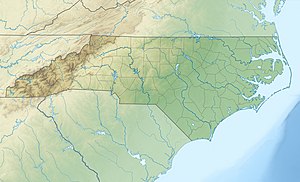Pamlico Sound
| Pamlicos and Pamlico Sound |
||
|---|---|---|
| Waters | Atlantic Ocean | |
| Land mass | North America | |
| Geographical location | 35 ° 19 ′ N , 75 ° 56 ′ W | |
|
|
||
| width | 48 km | |
| depth | 129 km | |
| Tributaries | Neuse River , Pamlico River | |
|
Pamlico Sound with catchment area |
||
The Pamlico Sound (also Pamlicosund ) in the state of North Carolina in the United States of America , forms the largest lagoon on the east coast of the United States with a length of 129 kilometers and a width of 24 to 48 kilometers .
The sound is separated from the Atlantic by the offshore island chain of the Outer Banks , a series of low and sandy islands . Cape Hatteras is one of these islands in front of the Pamlico Sound . The Neuse and Pamlico Rivers flow from the west , the latter forming the estuary of the Tar River . In the north, the Pamlico Sound is connected to the neighboring large Albemarle Sound by the small sounds Roanoke and Croatan and belongs to the Atlantic Intracoastal Waterway . The narrow south end is formed by the core sound.
The Pamlico Sound is part of the large network of interconnected estuaries that together form the largest estuary in the United States after the Chesapeake Bay . The area can be divided into seven different "sounds": Albemarle Sound, Currituck Sound, Croatan Sound, Pamlico Sound, Bogue Sound, Core Sound and Roanoke Sound.
On the offshore islands there are the nature reserves Cape Hatteras National Seashore and Cape Lookout National Seashore , on the banks of the Sound there are several nesting areas for water birds, these nesting sites are protected in the Pea Island National Wildlife Refuge and Swanquarter National Wildlife Refuge on the mainland.
The explorer Giovanni da Verrazzano mistakenly believed the sound to be the Pacific Ocean when he arrived in America . The sound itself and its connections into the open sea are difficult for larger ships to pass, wide sandbanks and shallow water make the passage dangerous. In addition, the sound's shallow basin makes it susceptible to changes in water levels caused by wind and air pressure. The effect can be observed in the flowing rivers, where the level can rise by up to 60 centimeters within three hours if the wind is on the axis of the river and it is strong. The region around Cape Hatteras is also known as the Graveyard of the Atlantic (Eng. "Ship graveyard of the Atlantic").

